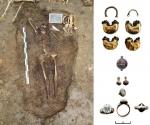Summary (English)
PHILIPPOPOLIS (Elena Bozhinova – elena.bozhinova@gmail.com, Kamen Stanev) The site was situated at the southwestern foot of Teximtepe, under the Late Antique fortification wall. A quarry for ashlars functioned there during the 2nd – 3rd centuries AD. During previous excavations in the neighboring site located to the south, sectors from a water-conduit of the Roman period were explored and coins, a bronze-finger-ring, a fragment from a marble statue, fragments from architectural details and a buckle of the 5th century AD related to foederati were found. The excavations in 2014 revealed that during the 12th – beginning of the 13th centuries the site was occupied, while the later cemetery destroyed the stratum. The finds included sherds, a scyphate, fragments from glass bracelets, a finger-ring, a lead ampoule produced in Asia Minor, a fragment from a bronze procession cross and a spherical stone projectile. The Christian cemetery functioned during the 14th – 17th centuries and 157 graves situated on several levels were explored. Some of the graves were surrounded with stones and bricks. There were stones placed as funerary slabs above some of the burials. Carbonized remains from wooden coffins were documented in many graves. Bones from earlier burials were placed along the bodies in many graves. A ritual pit for reburial of bones from earlier graves was discovered as well. In one burial, the face of the dead was covered with a roof-tile, a fragment from a brick was placed in his mouth and his feet were tied together. The grave goods included a silver and a bronze finger-ring of the 14th century, jewelry and buttons of the 15th – 17th centuries, c. 330 bronze and silver coins, including a hoard of 10 silver coins. The richest burial belonged to a woman, c. 20 years old, who was buried in a wooden coffin with a pair of gold earrings of the 14th century, four silver buttons, a silver finger-ring of the middle of the 15th century and silver brocade. The excavated graves were situated in the eastern periphery of a large cemetery.
Director
- Elena Bozhinova - Archaeological Museum - Plovdiv
- Kamen Stanev - Ministry of Culture
Team
Research Body
- Archaeological Museum – Plovdiv






![Download [PDF]](/excavation/skins/fasti/images/results/download_sml.png)

